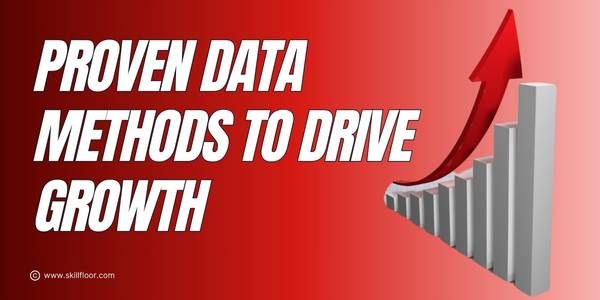Methods of Data Analysis for Business Growth
Boost business growth with data analysis. Learn how to analyze data, identify trends, and make data-driven decisions for optimized customer experience and improved operations.

Why does business these days revolve around data? These days, businesses collect a ton of data, from website visitors to sales records. However, the truth is that data alone is insufficient. Many companies lose out on growth because they aren't making the most of data.
Businesses collect vast amounts of data as they expand. The problem is that data collection does not ensure growth. Turning data into meaningful actions is a challenge for many firms. I've seen businesses with data goldmines that aren't aware they're losing out on significant discoveries that may increase revenue, enhance customer satisfaction, and simplify operations.
I'm here to guide you through efficient data analysis techniques that can advance your company. This manual is straightforward and provides helpful advice for people of all skill levels. You will learn how to use data to make informed, strategic decisions at the end. Let's unleash the potential of your data!
What is Data Analysis?
Data analysis is the process of examining, cleaning, and interpreting raw data to find valuable information. It involves identifying patterns, trends, and insights in data or text to assist organizations in developing more intelligent, well-informed plans and choices. Many professionals increase their grasp of these abilities by taking analytics courses.
When done correctly, data analysis may forecast future events, uncover untapped possibilities, and pinpoint trouble spots. Data analysis transforms complicated information into insightful knowledge that may inspire decisions that can increase productivity and spur development, regardless of the size of your company.
Importance of Data Analysis in Modern Business
-
Businesses may make better judgments by using data analysis to identify trends and patterns. It offers instantaneous insights into what is and is not functioning.
-
Businesses may enhance their goods and services by better understanding their consumers with the use of data analytics. Personalized experiences that increase client happiness and loyalty may be fuelled by knowledge of their preferences.
-
Businesses are able to find inefficiencies and optimize processes through data analysis. Time and money are saved by this method, which frees up resources for where they are most needed.
-
Businesses may better prepare for changes by using predictive analysis, which forecasts future patterns based on historical data. Businesses are able to keep ahead of the competition because of this proactive attitude.
-
Through the identification of important demographics and the monitoring of campaign efficacy, data analysis aids marketing. By using this information, companies may develop audience-relevant campaigns.
-
Data analysis is used by businesses to gauge overall performance. By monitoring important data over time, businesses may pinpoint areas for expansion and make necessary adjustments to their strategy.
The Impact of Big Data on Business Analytics
1. Data-Driven Decision Making
Big data gives companies access to a wealth of information, enabling them to make data-driven choices. It aids businesses in comprehending consumer behavior and market trends more broadly.
2. Enhancing Product Development
Big data analysis gives companies insights that enhance product development. Producing goods that really satisfy consumer wants requires an understanding of consumer preferences and requirements.
3. Expertise in Big Data Analysis
Insights may be gleaned from complicated data sets by Certified Business Analytics professionals. Businesses are able to optimize the benefits of their big data initiatives because of this experience.
4. Personalized Marketing Strategies
Big data helps companies more accurately segment their consumers, which helps with tailored marketing. This makes it possible to provide more focused messages, which raises engagement and increases conversion rates.
5. Optimizing Operational Efficiency
Businesses can track and improve operational efficiency with big data. It draws attention to inefficiencies and bottlenecks, which helps to simplify procedures and cut expenses in daily operations.
6. Proactive Risk Management
Finding patterns linked to possible hazards is one way that big data enhances risk management. By doing this, companies may proactively resolve problems and make choices that lessen uncertainty in the future.

How Businesses Can Use Data for Real Growth
Businesses may achieve genuine success by converting raw data into actionable insights that inform strategy and decision-making. I have worked with data-driven organizations for years, and I have seen directly how concentrating on data analysis helps businesses identify possibilities, identify their strengths, and remain flexible in a very competitive market.
Gaining insight into consumer behavior is essential for business expansion. Businesses may customize their offers to increase customer happiness and loyalty by monitoring trends and feedback. Methods of Data Analysis like predictive analytics also assist businesses in foreseeing demand, preparing for changes, and addressing risks, enabling them to make proactive, growth-oriented choices.
With so many tools and training opportunities, investing in data analytics has never been simpler. By cultivating a data-driven culture where insights inform decisions across departments, many businesses are seeing notable success. Data-driven planning is increasingly crucial for companies that want to grow and remain flexible.
Effective Methods of Data Analysis to Drive Real Business Growth
1. Descriptive Analysis: Understanding What Happened
Definition: The majority of data work begins with descriptive analysis. It analyzes historical data over certain periods, condensing vast volumes of information into important insights, patterns, and trends that demonstrate historical performance.
Application: Descriptive analysis is used by businesses to analyze website traffic, track sales patterns, and research consumer demographics. These methods of data analysis assist companies in determining which items are the most successful.
Benefit: Businesses can see how they are doing right now thanks to descriptive analysis, which lays a solid basis for future expansion. These insights assist data analysts in identifying areas for improvement and in directing more complex analytic methods.
2. Diagnostic Analysis: Investigating Causes Behind Outcomes
Definition: Diagnostic analysis takes one step further to determine "why it happened," whereas descriptive analysis only discloses "what happened." This method looks at data linkages and trends to determine the underlying reasons for particular results.
Application: Diagnostic analysis is a tool used by businesses to examine changes in performance. These methods of data analysis can identify factors like price or competition activity, for instance, if a retail outlet has a decline in foot traffic.
Benefit: Diagnostic analysis is essential for addressing specific issues. Businesses may make targeted changes by recognizing certain problems, such as altering their approach, improving customer service, or honing data analytics tools for more consumer interaction.
3. Predictive Analysis: Forecasting Future Outcomes
Definition: Predictive analysis is a forward-looking method that forecasts future occurrences using historical data, machine learning, and statistical models. Businesses may better predict trends and get ready for shifts in consumer tastes and demand thanks to it.
Application: Demand planning, risk assessment, and sales forecasting all make use of predictive analysis. These methods of data analysis might be used by a retail establishment, for instance, to predict peak seasons and make sure that popular goods are well stocked.
Benefit: Businesses can plan with confidence thanks to predictive analysis. Businesses may make informed decisions that enhance resource allocation, maximize inventory, and adjust marketing to match expected demands by gaining insights into predicted patterns.
4. Prescriptive Analysis: Recommending Actions for Optimal Outcomes
Definition: Prescriptive analysis suggests certain activities for the best results, going beyond trend prediction. It is one of the most effective methods of data analysis for decision-making since it delivers practical actions using sophisticated algorithms.
Application: Companies utilize prescriptive analysis for supply chain management, tailored marketing, and pricing optimization. Based on supply levels and consumer demand, for instance, an online merchant can get recommendations to modify prices.
Benefit: By providing suggestions that are supported by facts, prescriptive analysis eliminates uncertainty from decision-making. By acting on lucid, strategic insights, these data analytics apps enable businesses to improve customer happiness, accelerate growth, and raise efficiency.

5. Regression Analysis: Examining Relationships Between Variables
Definition: The statistical technique of regression analysis looks at the connections between variables. It is one of the fundamental methods of data analysis because it demonstrates how changes in one element, like price, affect another, like sales.
Application: Companies use regression analysis to forecast sales and other outcomes based on factors like seasonality and advertising expenditure. For instance, it assists businesses in comprehending the effects of adjustments to marketing spending on total revenue.
Benefit: Regression analysis finds patterns and helps make data-driven choices. Businesses are able to discover the main factors that influence results, which aids in resource optimization and directs strategic choices that promote expansion in certain areas.
6. Cluster Analysis: Grouping Similar Data for Insights
Definition: A technique called cluster analysis puts related data points into groupings according to common traits. It is one of the methods of data analysis that aids in the identification of groups of customers with comparable habits or tastes.
Application: Cluster analysis is used by businesses for market research, product grouping, and consumer segmentation. To improve targeted data analytics applications, businesses could, for instance, classify customers as "frequent buyers" or "seasonal shoppers."
Benefit: By customizing techniques for distinct client segments, cluster analysis enables organizations to offer more individualized marketing, focused promotions, and improved product suggestions. Building more client pleasure and engagement requires it.
7. Sentiment Analysis: Understanding Customer Emotions and Feedback
Definition: To determine the emotional tone of text data, sentiment analysis, also known as opinion mining, analyzes the data. Businesses may use these methods of data analysis to assess consumer thoughts and comments from sources including surveys, social media, and reviews.
Application: Sentiment analysis is a tool used by businesses to monitor brand sentiment, follow consumer feedback, and gauge public opinion. For instance, following the debut of a new product or service, client satisfaction levels can be determined by examining social media comments.
Benefit: Businesses may fix issues, improve goods, and create a great brand experience by using sentiment analysis, which provides insight into consumer views. It is essential for long-term consumer loyalty and reputation protection.
Here are Some Tools and Technologies for Effective Data Analysis
|
Tool/Technology |
Primary Function |
Key Features |
Best For |
|
Microsoft Excel |
Data manipulation & visualization |
Pivot tables, basic statistical functions |
Simple data analysis & quick reporting |
|
SQL |
Database querying & management |
Data retrieval, filtering, calculations |
Handling large, structured datasets |
|
Python |
Advanced data analysis & automation |
Pandas, NumPy, data manipulation, custom analysis |
Complex data analysis & automation |
|
Tableau |
Data visualization & reporting |
Interactive dashboards, easy data sharing |
Visualizing data for broader audiences |
|
Power BI |
Business intelligence & reporting |
Real-time reporting, data modeling |
Business decision-making & KPI tracking |
|
Google Analytics |
Web data analysis |
User behavior tracking, website traffic insights |
Digital marketing & web performance |
Practical Steps for Implementing Data Analysis to Drive Growth
1. Define Clear Objectives
Start by determining your goals for using data analysis. Establishing clear objectives, such as increasing customer retention or cost optimization, gives focus and guarantees that data initiatives support company expansion.
2. Collect Relevant Data
Collect just the most pertinent information from sources such as social media, sales stats, and customer reviews. The accuracy and effectiveness of your data collection procedure are increased when superfluous information is filtered out.
3. Choose the Right Tools
Invest in equipment that fits the demands and size of your business. For precise, easily accessible, and scalable insights, choosing the appropriate data analysis tools is crucial, whether using spreadsheets or more complex applications.
4. Clean and Organize Data
Make sure your information is correct, current, and arranged properly. Good data cleaning makes it easier to understand and use outcomes by removing mistakes, cutting down on redundancies, and guaranteeing accurate analysis.
5. Use Visualization Techniques
It's simpler to comprehend and communicate insights when data is visualized using graphs, charts, and dashboards. Teams can make decisions more quickly by using data visualization to identify trends and patterns.
6. Analyze Trends and Patterns
Examine your data for recurring patterns, correlations, and trends. Finding development opportunities and places where Data-Driven Decisions may have an impact need being able to recognize these insights.
7. Review and Refine Regularly
Keep assessing your analysis techniques and revising them as necessary. Your ability to adjust to changes and maintain alignment between analytical efforts and business objectives is ensured by regularly changing your data strategy.
Businesses can stay competitive and generate growth by embracing data analysis. Companies may turn unstructured data into insightful knowledge that helps them make better decisions by using the proper methods of data analysis. Every strategy provides value, from comprehending consumer behavior to streamlining processes and forecasting future patterns. Businesses may stay flexible and adaptable to changes by regularly improving and reviewing these methods of data analysis. Businesses may improve decision-making, forge closer bonds with clients, and leave a lasting impression in the fast-paced business world of today by using data-driven initiatives.




























































